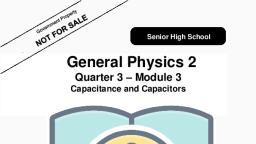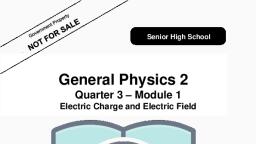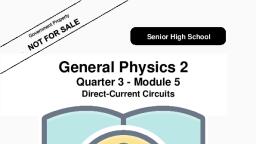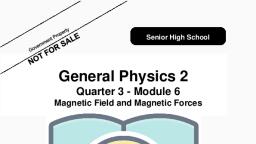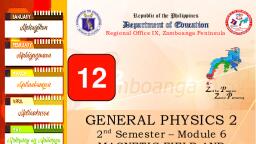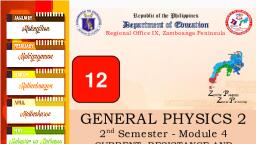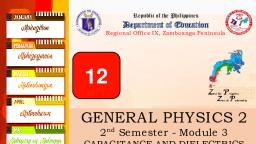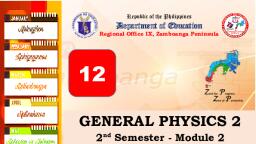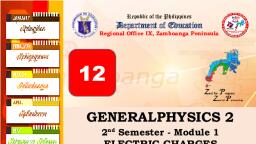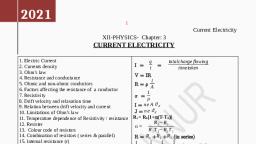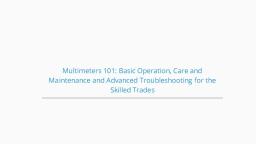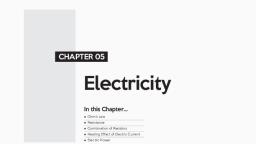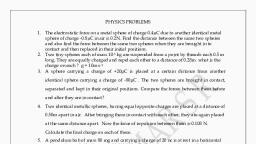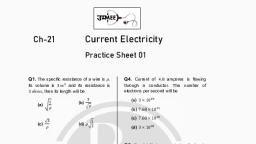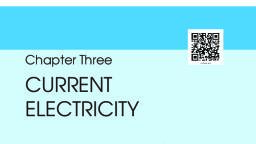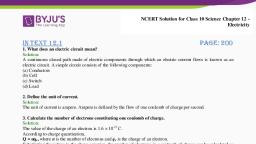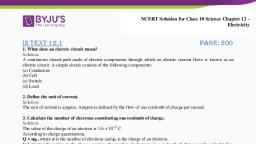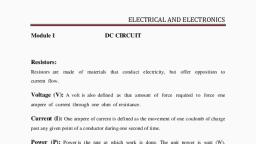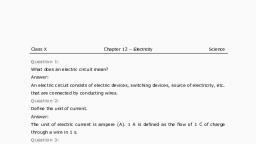Page 1 :
Republic of the Philippines, , Department of Education, Regional Office IX, Zamboanga Peninsula, , 12, GENERAL PHYSICS 2, 2 nd Semester – Module 5, DIRECT CURRENT CIRCUITS, , Name of Learner: ___________________________, Grade & Section: ___________________________, Name of School:, , ___________________________
Page 2 :
General Physics 2 - Grade 12 (STEM), Support Material for Independent Learning Engagement (SMILE), Module 5: Direct Current Circuits, First Edition, 2021, Republic Act 8293, section176 states that: No copyright shall subsist in any work of the, Government of the Philippines. However, prior approval of the government agency or office, wherein the work is created shall be necessary for the exploitation of such work for a profit., Such agency or office may, among other things, impose as a condition the payment of, royalties., Borrowed materials (i.e., songs, stories, poems, pictures, photos, brand names,, trademarks, etc.) included in this module are owned by their respective copyright holders., Every effort has been exerted to locate and seek permission to use these materials from their, respective copyright owners. The publisher and authors do not represent nor claim ownership, over them., , Development Team of the Module, Writer:, , Jeovanny A. Marticion, , Editor:, , Zyhrine P. Mayormita, , Reviewers:, , Leo Martinno O. Alejo, Zyhrine P. Mayormita, , Layout Artist:, , Chris Raymund M. Bermudo, , Management Team: Virgilio P. Batan Jr., , - Schools Division Superintendent, , Lourma I. Poculan, , - Asst. Schools Division Superintendent, , Amelinda D. Montero, , - Chief Education Supervisor, CID, , Nur N. Hussien, , - Chief Education Supervisor, SGOD, , Ronillo S. Yarag, , - Education Program Supervisor, LRMS, , Zyhrine P. Mayormita, , - Education Program Supervisor, Science, , Leo Martinno O. Alejo, , - Project Development Officer II, LRMS, , Janette A. Zamoras, , - Public Schools District Supervisor, , Joselito S. Tizon, , - Principal, Zamboanga del Norte NHS, , Printed in the Philippines by, Department of Education – Region IX– Dipolog City Schools Division, Office Address:, Telefax:, E-mailAddress:, , Purok Farmers, Olingan, DipologCity, Zamboanga del Norte, 7100, (065) 212-6986 and (065)212-5818, dipolog.city@deped.gov.ph
Page 3 :
What I Need to Know, This module will help you understand the concepts of current, resistance,, and electromotive force. At the end of this module, you should be able to:, (1) Evaluate the equivalent resistance, current, and voltage in a given, network of resistors connected in series and/or parallel, STEM_GP12EM-IIIg-48;, (2) Calculate the current and voltage through and across circuit elements, using Kirchhoff’s loop and junction rules (at most two loops only), STEM_GP12EM-IIIg-49; and, (3) Solve problems involving the calculation of currents and potential, differences in circuits consisting of batteries, resistors, and capacitors., STEM_GP12EM-IIIg-51., , What’s In, In the previous module, we have studied the principles of electric, currents within a simple circuit. However, if you take a closer look at a, computer, TV, radio, or any appliance, you will discover that these devices, have a complicated network of circuits. These circuits contain resistors,, capacitors, sources, transformers, motors, etc., For this module, you will be studying the methods in analyzing, networks from computing the unknown values of resistors, voltages,, currents, and capacitors. Series and parallel connections can be represented, by equivalent resistance. However, general networks can also be solved using, Kirchhoff’s two rules based on energy conservation and charge moving, around the loop., You will also deal with circuits that combine capacitors and resistors, where the current varies with time., These principles are needed to understand electrical wiring systems in, our homes., , 1
Page 4 :
What’s New, Critical Reading, Transmission lines and power plants were built to provide every, home and business establishment with electrical energy. There, was a hesitation when it was first introduced. Today, the country, is very dependent on electrical energy in every industry. However,, the energy crisis is currently a problem in the Philippines. This, pressing public concern leads to power interruption and causes, commerce and industry to stop. Hence, there is a need to, upgrade the electric grid to meet the recent demands on energy., The plan for SMART GRID is being pushed to achieve sustainable, development. The figure below shows the difference between a, smart grid and a standard grid., , Image Source: https://thoughtsprudencestrategy.blogspot.com/2020/03/smart-grid-vs-traditional-grid.html, , Activity 1. Towards A Smart City, Direction: Answer the following questions based on the material read and, the illustration given, (1) What are the three (3) features of a smart grid?, _________________________________________________________________________, , 2
Page 5 :
__________________________________________________________________________, __________________________________________________________________________, (2) How will you define a smart city? Is the characteristic of a smart city, similar to smartphones? In what way(s)?, __________________________________________________________________________, __________________________________________________________________________, __________________________________________________________________________, (3) The following characteristics of a smart grid are necessary to build a, smart city. Provide reason/s why these characteristics must be present in, every smart grid and how they will help sustain development?, Characteristics, , Why is this important in, building a smart grid?, , Efficiency, , Reliability, , Affordability, , Security, , Green Friendly, , 3, , How will it help create a, smart city?
Page 6 :
(4) Is it possible to build a smart grid in the Philippines? What, necessary actions are needed to fulfill this goal? (You may answer, from the perspective of a government leader or as an ordinary citizen.), _____________________________________________________________________________, _____________________________________________________________________________, _____________________________________________________________________________, _____________________________________________________________________________, , What Is It, Resistors in Series, R1, , R2, , R3, , The figure above shows the series combination of three, resistors with resistance R1, R2, and R3. In a series connection, the, path between points a and b is considered a single path. In this case,, the current across the circuit is always the same. Since the current is, the same throughout the resistors and by applying Ohm’s law to each, resistor, the potential difference for each resistor is:, , You can always check if the source of potential difference was, distributed throughout the components by getting the sum of V1, V2,, and V3., , From the expression, we can say that, , In accordance with Ohm’s law, R = V/I. Thus, the equivalent, resistance is just the sum of the resistance of every resistor expressed, as:, , 4
Page 7 :
Resistors in Parallel, , The figure above shows the parallel combination of three resistors, with resistance R1, R2, and R3. In a parallel connection, alternative paths, are given between points a and b. In this case, the potential difference, across the circuit is always the same. Since the potential difference is the, same throughout the resistors and by applying Ohm’s law to each, resistor, the current for each resistor is:, , The total current I must be equal to the sum of the three currents. Thus,, , (, (, , ), ), , In accordance with Ohm’s law, R = V/I. In this case,, , ., , Thus, the equivalent resistance is just the sum of the resistance of every, resistor expressed as:, , Example 1:, Compute the equivalent resistance for the, network below:, , 5
Page 8 :
A, B, , What is/are given?, What is asked?, , C, , Are the units, consistent with the, formula?, What strategy must, be employed?, , E, , F, , V = 18 V; R1 = 4Ω; R2 = 6 Ω; R3 = 3 Ω, (a) equivalent resistance, (b) potential difference for each resistor, Yes, , We use the formula for series and parall, connection. We need to find the equivalent, capacitance for 6 and 3 Ω resistors. If we have, the equivalent capacitance, we can now solve for, the equivalent capacitance of series combination., , Solution, equivalent capacitance, , Since R2 and R3 are in parallel connection, we will compute the, reciprocals of their resistance., , (, , ), , (, , ), , We were able to combine R2 and R3 leaving us a series connection of R1, and R23., , Since they are now in series, we can now solve for sum of individual, resistances., Since resistors are now in series, we can solve for the current (which is, similar in all components), , Thus, a current of 3A is running around the circuit. We will also solve, for the voltage drops or potential difference for each resistor using, Ohm’s law., , 6
Page 9 :
By checking:, , This means, a 6 V potential difference is present in the parallel, connection of R23 and a 12 V is present in R1. In determining the, current, we use the Ohm’s law and the value of 6 V., , G, , So far, the values for current are correct since the current traveling, around the circuit is 3A., What is the, Therefore, the equivalent resistance of the network is, conclusion?, 6Ω. The current and voltage of R1 are 3 A and 12 V,, respectively. The current and voltage of R2 are 1A and, 6 V, respectively. Finally, the current and voltage of R3, are 2A and 6 V, respectively., , Kirchoff’s Rules, Sometimes networks can’t be simplified using series-parallel, combinations. The figure below shows an example of a complicated, network, , Figure 1. An example of a network that could not, be reduced by simple series-parallel connection., Image Source: https://www.electronics-tutorials.ws/dccircuits/dcp_4.html, , 7
Page 10 :
In solving complicated networks, we will be using Kirchhoff’s, rules. However, be familiar with the following terms: junction and loop., A junction is a point where three or more conductors meet. A loop is the, closed conducting path., There are two (2) statements (points) under Kirchhoff’s rules., (1) Point Rule: The sum of the currents in the branch is always equal, to zero. This is based on the conservation of charges. Junctions, should not accumulate charges. Hence, the total current entering, the junction must be equal to the total current leaving the, junction. Figure 1 shows the 11 A current entering the junction., When it leaves the junction, the 11 A current splits into 7A and 4A, currents., , Figure 1. The values of currents, entering and leaving the junction, following the junction rule, , Figure 2. The diagram showing the, currents leaving and entering the, junctions., , Image Source: https://phys.libretexts.org/Bookshelves/University_Physics/Book%3A_University_Physics_(OpenStax)/Book%3A_University_Physics_II__Thermodynamics%2C_Electricity%2C_and_Magnetism_(OpenStax)/10%3A_Direct-Current_Circuits/10.04%3A_Kirchhoff%27s_Rules, , The junction rule is expressed as the sum of current, which is, equal to zero, , ∑, (2) Loop Rule: The sum of the potential differences in any loop must, equal to zero. This is an expression of the energy relationship. As a, charge goes around the loop and returns to its starting point, the, sum of the changes of its potential energy is equal to zero. Figure, 3 shows the loop rule., , Figure 3. Kirchhoff’s Loop Rule, Image Source: https://phys.libretexts.org/Bookshelves/University_Physics/Book%3A_University_Physics, _(OpenStax)/Book%3A_University_Physics_II__Thermodynamics%2C_Electricity%2C_and_Magnetism_(OpenStax)/10%3A_Dire, ct-Current_Circuits/10.04%3A_Kirchhoff%27s_Rules, , 8
Page 11 :
This is expressed as:, ∑, It will not matter which direction or loop you would like to assume., If we have wrong guess of its direction, we will get a negative value for the, current. If we have the correct guess of its direction, we will get a positive, value for the current. Let us be reminded with the following sign, conventions:, , Figure 4. Sign conventions for the loop rule. (a) Negative potential if the, assumed direction of loop is the same with the direction of current; (b), Positive potential if the assumed direction of loop is opposite with the, direction of current; (c) Positive potential if the direction of the assumed, direction of loop is from negative terminal to positive terminal; and (d), Negative potential if the assumed direction of loop is from positive to, negative terminal. Image Source: https://cnx.org/contents/7DqkHtKM@2/Kirchhoff-s-Rules, The most difficult part in dealing with Kirchhoff’s rules is, keeping track with signs. The rules and principles are easy to, understand., Example 2:, In the circuit shown below, find the, unknown current I, the resistance R, and, the emf, , ε., , 9
Page 12 :
What is/are given?, What is/are asked?, , 1A across 2Ω, 6A across 2 Ω and 18 V, , Strategy:, , First, we assume the direction of, currents in junction a. The charges will, start traveling from the positive terminal, of the sources and end in negative, terminals, , ε, R1 and current across R1, , We assign junction a as an application for junction rule., , We obtain, (1), Next, we assume the directions of the loop 1, 2 and 3., , 10
Page 14 :
We solve for the unknown values using equations 1,2,3 and 4, Solve for I using equation 1:, Hence, we have the correct assumption of the direction of current., The unknown current is 5A. Substitute this value in equation 2:, 18 V – IR1 + 1 A(2Ω) = 0, 18 V – (5A) R1 + 1 A(2Ω) = 0, – (5A) R1 = -18 V – 2V, –, , =, R1 = 4Ω, , The unknown resistance is 4Ω., Solve for ε using equation 3, 1 A (2Ω) + 6A (2Ω) + ε = 0, 2V + 12 V + ε = 0, ε = -14 V, Therefore, the unknown emf is -14 V, The negative value obtained implies that the actual polarity of the emf is, opposite from our assumption. The positive terminal should lie on the right, life side., Measuring Devices, The measuring devices are used to measure the quantities involved in, studying circuits., (1) Galvanometer is a device used in detecting the presence and direction, of electric current in the device., (2) Multimeter is also a measuring device that could measure current,, resistance, and voltage., (3) Ammeter is used to measure the magnitude of current passing, through the device., (4) Voltmeter is used to measure the voltage or potential difference., Both ammeter and voltmeter are used to measure the resistance or, power. Figure 4 shows the method for measuring the current and voltage of, the circuit., , 12
Page 15 :
Figure 4. Methods in measuring current and voltage, using ammeter and multimer., Image Source: https://forum.allaboutcircuits.com/threads/kitchen-play-centre-for-kids.129179/page-2, , Resistance-Capacitance Circuits, The figure below shows a simple circuit diagram of capacitor, voltage, source and resistor. At some time t, we close the switch to allow the, capacitor to charge. As the capacitor charges, the voltage increases and the, potential difference across the resistor decreases. However, the sum of the, voltage drops is equal to V., , When the capacitor is fully charged, the potential difference across the, resistor becomes zero, the current becomes zero and the voltage appears, now at the capacitor. This is expressed as:, , As shown in Kirchhoff’s rule:, , Solving for current i, , As the charge increases, q/RC becomes larger and the capacitors reaches, final value denoted as Qf. The current i becomes zero., , 13
Page 16 :
Hence,, It was also found out that when capacitor reaches the final value, ,, the time it takes is equal to RC. The product RC is then the measure of how, quick the capacitor charges also known as time constant or relaxation time:, , Example 3: A resistor with resistance R = 10 MΩ is connected in series with, a capacitor with capacitance 1 µF. What is the time constant?, A, B, C, , What is/are given?, What is asked?, Are the units, consistent with the, formula?, , E, , What strategy must, be employed?, Solution, , F, G, , What is the, conclusion?, , C = 1 µF; R = 10 MΩ, No, µF must be converted to F, 1 µF = 1 x 10-6 F, and MΩ to Ω, 10 MΩ = 10 x 106 Ω, We use the time constant formula, , Therefore, it takes 10 seconds for the capacitor to be, fully charged., , What’s More, Activity 2: Qualitative Problems., Direction: Answer the following questions., (1) Some Christmas tree lights have a characteristic that when one light, (filament) burns out, the lights throughout go out too. However, burned-out, lights go out in other series lights. Discuss the difference of these two sets, of lights., __________________________________________________________________________, __________________________________________________________________________, __________________________________________________________________________, __________________________________________________________________________, , 14
Page 18 :
What I Have Learned, Activity 3: Quantitative Problem, Direction: Solve as directed. Write your answers on a separate sheet of, paper. You may also consult your Physics teacher., Find the unknown values of voltage and current in each resistor as shown in, the given circuit diagram., , Criteria, Physics, Approach, , 3, Approach is, appropriate and, complete, , 2, Approach, contains minor, errors, , Procedure, , Mathematical, and logical, procedures are, clear, complete, and connected, Diagrams and, symbols used, are appropriate, and complete, , Mathematical and, logical procedures, are, missing/contain, errors, Parts of the, diagrams and, symbols contain, errors, , Description, , 16, , 1, Some of the, concepts and, principles are, missing or, inappropriate, Most of the, mathematical, and logical, procedures, , 0, Solution, doesn’t, indicate an, approach, , Most of the, parts of the, diagrams and, symbols are not, useful, , The entire, visualization, is wrong or, did not, include, visualization., , All procedures, are incomplete, and contain, errors
Page 19 :
What I Can Do, Activity 4. Building Concept Map., Direction: Create a concept map to show what you have learned from this, module. You can use words, terms, phrases, or formulas in connecting, these concepts. Refer to the scoring guide below:, Legible (easy, No (0-1), Yes (2), to read), Accurate, Many inaccuracies A few inaccuracies No inaacuracies (5), (concepts were (0-2), (3-4), used, accurately), Complete, Limited use of, Some use of, Sufficient number, (sufficient, concepts, concepts, of concepts, number of, (0-2), (3-4), (5), relevant, concepts and, relationships), Sophisticated Little or, Few, Some, Meaningful, (finding, none, meaningful, meaningful, and original, meaningful, (0-1), connections, connections, insights, connections, made (2-4), made (5-7), demonstrated, between, (8), relevant, concepts), Mueller’s Classroom Concept Rubric, , Assessment, Directions: Write the letter of your choice in the space provided., ____ 1. In a parallel combination of resistors, the current is, a. varying, b. same, c. greater in value, d. lesser in value, ____ 2. In a series combination of resistors, the voltage drop is, a. varying, b. same, c. greater value, d. lesser value, ____ 3. What happens to the energy when the electron goes into the 2nd, bulb after passing through the 1st bulb?, , 17
Page 20 :
a. greater energy, b. lesser energy, c. increasing power, d. decreasing power, ____ 4. When resistors are connected in parallel, what happens to their, resistance?, a. more than the smallest resistance, b. within the values of larges and smallest resistance, c. less than the smallest resistance, d. depends on the voltage drop, ____ 5. The Kirchhoff’s rule on voltage drops is consistent with, a. energy conservation, b. impulse and momentum, c. conservation of charge, d. angular momentum conservation, ____ 6. A 20 V potential difference is applied in a series combination of a, 10 Ω and a 30 Ω resistors. The current in the 10 Ω resistor is, a. 0.5 A, b. 0.3 A, c. 0.67 A, d. 0.2 A, ____ 7. The potential difference across the 10 Ω resistor in No. 6 is, a. 5 V, b. 10 V, c. 15 V, d. 20 V, ____ 8. The equivalent resistance in No. 6 when connected in parallel is, a. 0.54 Ω, b. 0.25 Ω, c. 7.5 Ω, d. 24 Ω, ____ 9.Which of the following statements is true for the junction below:, 1, 2, 3, , a. I1 + I2 = I3, b. I3 + I2 = I1, c. I1 – I2 = I3, d. I3 – I2 = I1, For No. 10, please refer to the figure below:, , 18
Page 21 :
____ 10. Applying voltage rule of Kirchhoff, the loop gives:, (a) E1 − E2 = I1r1 + I2r2, (b) E2 = E1 + I1r1 + I2r2, (c) E1 + E2 = I1r1 + I2r2, (d) E1 + I1r1 = E2 + I2r2, For Nos. 11 to 12, refer to the figure below:, , ____ 11. The smallest current that passes through is __________?, a. 10 Ω resistor, b. 20 Ω resistor, c. 60 Ω resistor, d. 30 Ω resistor, ____ 12. The largest potential difference is dropped at?, a. 10 Ω resistor, b. 20 Ω resistor, c. 60 Ω resistor, d. 30 Ω resistor, ____ 13. How long would it take for the capacitor to reach 4.1 V if it has a, 1 µF and connected with 2800 Ω resistor., a. 0.0003 s, b. 3 s, c. 0.000000003 s, d. 0.003s, ____ 14. What is the initial current of the circuit?, a. 2.21 x 10-3 A, b. 3.14 x 10-3 A, c. 0.17 x 10-3 A, d. 1.46 x 10-3 A, ____ 15. The current flowing in the branches can be determined through, a. Lenz laws, b. Coulomb’s laws, c. Kirchhoff’s rule, d. Gauss’s laws, , 19
Page 22 :
Additional Activities, Activity 5. Social Context, Direction: The community is a rich source of learning opportunities of, sources of direct current circuits. Choose one from the following, suggested activities in understanding the importance and utilization of, electric potential in our daily lives:, 1., 2., , 3., , Conduct simulations on direct current circuits. From this, write a short, reflection. Scan the QR code to gain access to the simulations., Demonstrate the series and parallel connections using batteries, bulbs,, wires, and multimeter. Compare how series and parallel connections are, different from each other. Design a data collection sheet where you can, record the quantities., Suppose you have an 1800 W toaster, 1400 W electric frying pan, and a, 75 W lamp plugged in a 20A, 120 V circuit. The devices are in parallel, connection with the voltage source. What is the current drawn in each, device? Will this combination blow a fuse (20 A)?, , Answer Key General Physics 2 Module 5, , 20
Page 24 :
22


